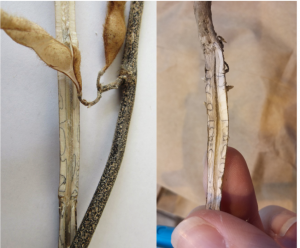The following is posted on behalf of Dr. Nathan Kleczewski, Field Crops Pathologist for Growmark. This content is from the Field Crop Disease Hub webpage Dr. Kleczewski curated.
Charcoal rot is a disease that we see in years where soybeans are stressed for a significant portion of the season due to drought. If you look at older references and publications in the field of soybean pathology, you will see that many show images of microsclerotia, which look like tiny peppercorns, within split stems. These microsclerotia are caused by Macrophomina phaesolina, the causal agent of of Charcoal rot. Many older soybean disease references will show black zone lines in these same images.

Some references even state that the zone lines are associated with or caused by M. phaseolina. Recently I was asked by several people about these zone lines, and if they indeed are signs of charcoal rot. If there is one thing that prevents proper disease management, it is misidentification of the disease and disease agent. If you misidentify the disease, you can find yourself out a significant amount of money. Let’s see what the primary literature says, shall we?
Roughly five years ago researchers at NDSU, in coordination with multiple other collaborators, conducted a study to determine the cause of zone lines in soybean stems.
Participants sent samples for processing, and a combination of isolation techniques and molecular techniques were used to determine exactly what was the cause of the dark zone lines. This was important because the zone lines were occurring without other symptoms of charcoal rot, and under situations where we would not necessarily expect charcoal rot issues. After collecting samples from many states, and isolating from zone lines, 90 isolates were obtained. A region of DNA that is used to identify many types of fungi was amplified from each isolate using PCR, and analyzed. Data indicated that the zone lines were not caused by M. phaseolina, but Diaporthe longicolla- a pathogen that causes pod and stem blight. A follow-up experiment was conducted where the D. longicolla isolates were inoculated onto healthy soybean plants and zone lines were observed. Thus, we now know for certain that zone lines are definitely not indicative of charcoal rot.
This subject is a great way to demonstrate why in plant pathology we require the completion of something called Koch’s Postulates before we know for certain that something is the cause of a particular disease. Simply being associated with diseased plant or tissue does not mean that the fungus actually caused the issue.





